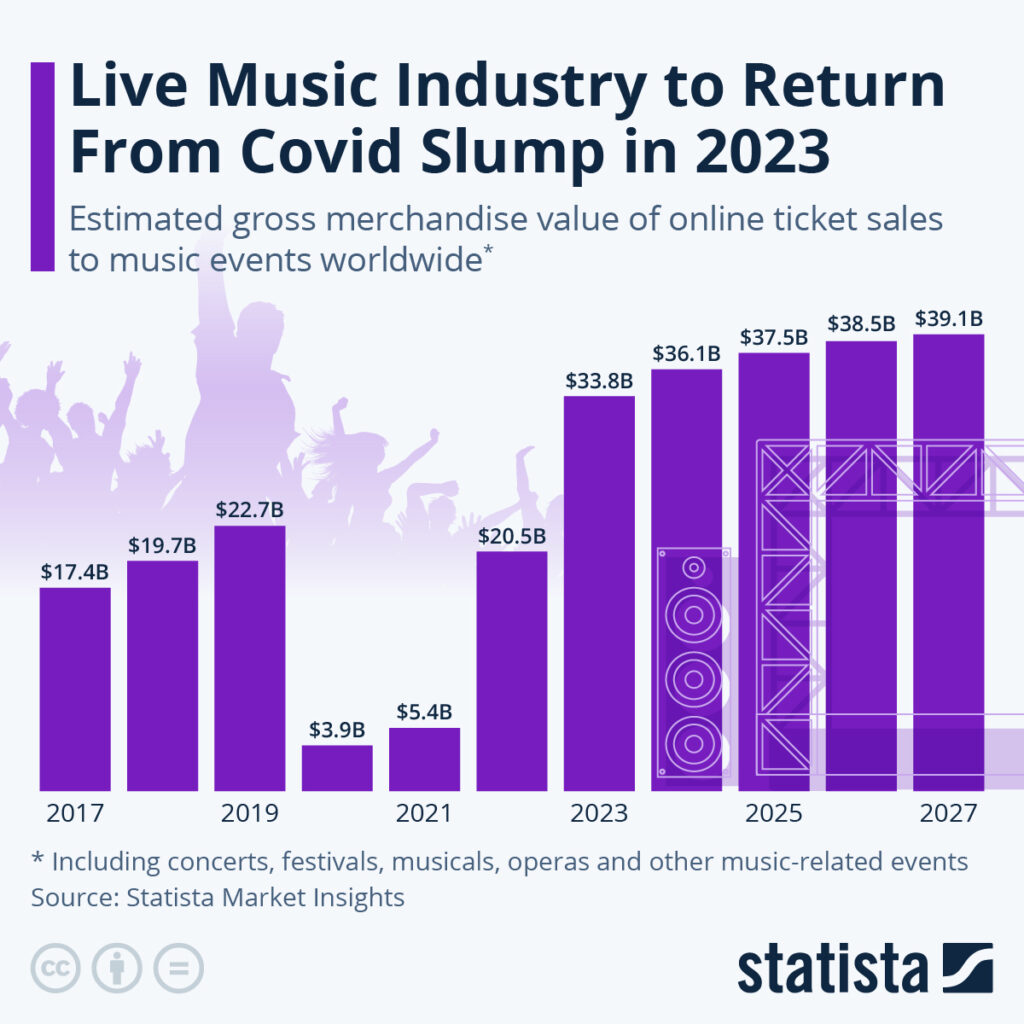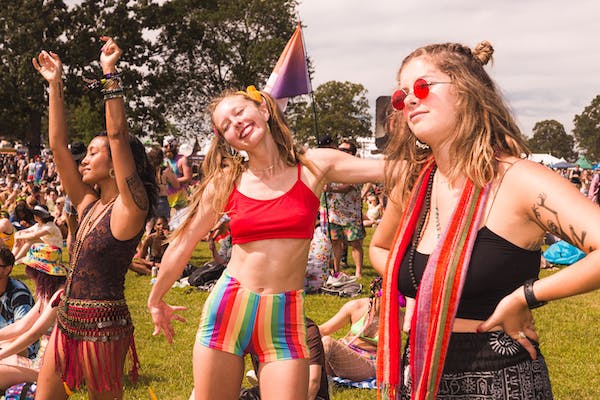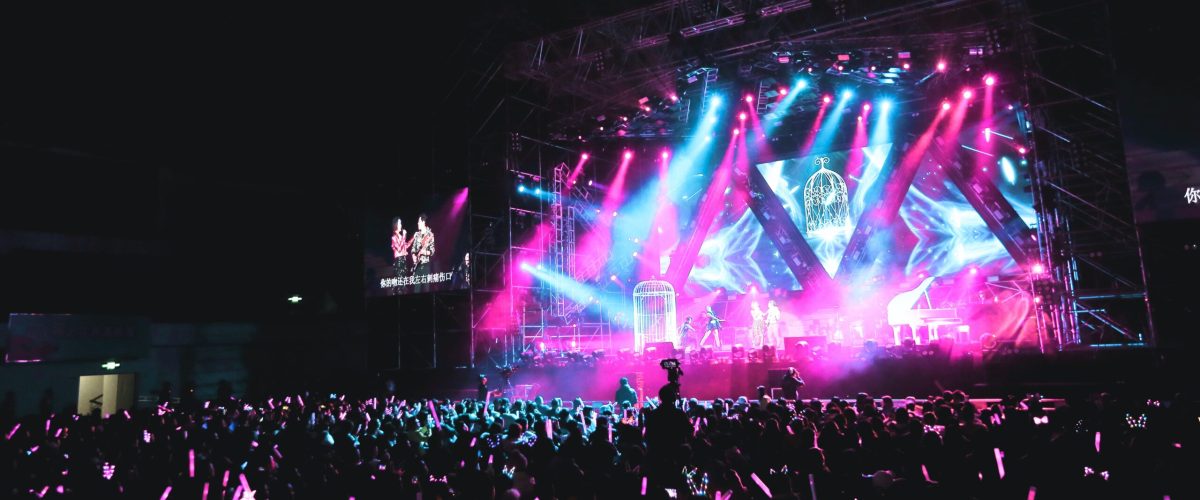After three years of Covid-impacted music festival seasons, 2023 is seeing a long-awaited return-to-normal. According to estimates from Statista Market Insights, the entire music event industry, including festivals and concerts but also musicals and operas, is expected to return to its pre-pandemic growth trajectory this year. Statista expects online ticket sales for music-related events to reach $33.8 billion this year, up 65 percent from 2022 and 49 percent from 2019, the last pre-pandemic year.
 Other Statistics about Music Festivals (source).
Other Statistics about Music Festivals (source).
- In 2019, the global music festival market was worth approximately 3 billion US dollars.
- A 2017 survey found that approximately 31% of respondents attended a music festival to discover new music.
- In 2016, 81% of music festival-goers preferred cashless payment methods at festivals.
- 14% of surveyed US music festival attendees in 2016 used virtual reality at a festival.
- 74% of festival attendees in 2017 believed that music festivals offer a sense of escape from daily life. Festivals are a suitable environment for bonding and spending quality time with friends and family, as everyday routines are left behind
- 6% of People That Go to Music Festivals Like to Have Sex at the Festival Itself
The growth in the number of music festival attendees is good news for music festival organizers and promoters. In today’s post, I will attempt to unravel some important information about what we know about music festival patrons.
Whether you call them attendees, patrons, guests, participants, or goers, the people who attend music festivals are the key ingredient to a successful music festival. Whether you goal is to build the experience around those you hope to attend (target audience) or whether you create an experience first and then hope to draw people to it, it still boils down to knowing the right audience to market to.
Some things to remember that apply to music festivals:
- The most likely people to purchase a product are those that previously purchased it with a good experience.
- The Pareto Principle (the 80/20 rule) applies to your music festival. That means that 80 percent of your outcomes come from 20 percent of your efforts. As you will see, twenty percent of your target audience will account for 80 percent of your sales.
- Today’s consumer is looking for something beyond the quality of the product or service. Today, it’s all about providing the best customer experience. Customer experience beat product and pricing for the third time in a row in a survey by SuperOffice of business professionals. That explains why some major festival sell out before the lineup is announced and why some very successful festivals rank lower in their lineup than others that draw less people.
- A good customer experience leads to people spending more. That means you also need to understand what your target audience expects when it comes to music festivals.
We’ve dug deep into data from Nielsen Music reports, Festival Pro insights, and other sources to find answers that might surprise you! The data available dates from before the Covid pandemic.
Unraveling the Demographics of Music Festival Target Audiences
The music festival scene had seen a tremendous increase in popularity, reflected by the spike in ticket sales and attendance before the pandemic. But who were these dedicated music festival goers? Let’s explore their demographics.
We will also explore the characteristics of a smaller subset of music festival attendees uncovered by a survey of 1,000 people in North America who attended a music festival in the last 12 month conducted by MusicWatch in 2016. They uncovered one type of festival fan driving more growth than all the rest. They termed this festival audience as the “hardcore festie.” This festival audience attends an average of 5-6 music festivals per year, and is responsible for more than half of the total annual spend on festival tickets in North America. They constitute about 20 percent of festival goers. Their characteristics have some differences from the average festival attendee found in the Nielsen study.
Age Distribution Among Festival Goers
The average age of attendees varies depending on the genre and lineup; however, most music festivals tend to draw a young adult crowd, typically between the ages of 18 and 35. Millennials are the largest segment of festival attendees.
The data from Nielsen’s 2015 Audience Insights Report on Music Festivals, found that approximately 32 million people attended at least one music festival in the U.S. each year. The young adults’ age group is dominant among attendees – about 46% of them fall between ages 18 to 34. Gitnux reports an increase to 56.3% of festval attendees in 2018 for this age group.
This makes sense considering festivals like Austin City Limits or Ultra Music have an immense popularity among this demographic. Additionally, the presence of renowned performers as the main acts at these gatherings tends to appeal more strongly to younger audiences, resulting in a higher average age among attendees that skews towards youthfulness.
Hardcore Festival Attendees
Their average age was found to be 32 in the MusicWatch study.
Gender Split in Music Festival Attendance
Moving beyond age groups, another fascinating aspect is gender distribution at these events. Here too, Nielsen’s report provides us with insightful data – it reveals an almost equal split amongst men (49%) and women (51%). This suggests that live nation-wide festivals cater equally well to both genders through a wide range of musical preferences offered across various stages.
In other words, whether you’re a fan of rock music heavyweights like Kate Bush or love shaking your groove thing to some infectious dance tunes spun by top DJs during summer music fests; there’s something for everyone.
Gitnux reports that approximately 46% of music festival attendes in 2016 were female (Digital Music News) which diffreres from the Nielsen figures reported in 2015.
Hardcore Festival Attendees
They are more likely to be male (59%) than female (41%)/
Other Characteristics of Music Festival Fans or Target Audiences
- Most festival fans are willing to travel large distances to attend their favorite festivals. Nielsen found that festival fans travel 903 miles to attend a festival. Half of hardcore festival attendees have traveled outside of their state or province to attend a festival.
- A third attend more than one festival in a year. The MusicWatch study found 30% attend one festival each year; 50% attend two to three each year; and 20% attend an average of five or six festivals per year.
- They are more digital than the typical consumer. They rely on tech and social media sournces to engage with music. They are twice as likely to use social media to access music than the U.S. average and are 98% more likely to discover new music on Spotify and purchase digital music than the typical U.S. consumer. In 2019, 47.6% of digital consumers attended at least one music festival in the U.S.
- A 2017 survey found that approximately 31% of respondents attended a music festival to discover new music.
- Compared with the general U.S. population, they also show greater levels of engagement with social media channels. They’re more likely to use it three or more times a day, and they’re especially active across social networks while attending live events.
- Frequent festivalgoers actively attend live music concerts, meaning that live music is an essential part of a frequent festival attendee’s life.
- They prefer the use of technology at festivals including such things as RFID wristbands, cashless payments, live streaming, etc.
- Hardcore festival attendees are 50% more like to consider using a wristband to pay for concessions and merchandise.
As promoters and organizers of these events, it’s crucial to understand what drives this group: their spending habits, where they discover new music, how they engage with artists on social media. This insight can help tailor not only the lineup but also the overall festival experience.
Spending Habits of Festival Fans

According to Nielsen’s Music 360 U.S. study in 2015, festival fans spent an average of $207 on live events, digital music, and streaming. Their passion for music extends beyond festivals, as they are willing to support artists by purchasing merchandise and subscribing to premium services like Spotify Premium or Apple Music.
Festival organizers know that some fan types drive more revenue than others. They may be VIP buyers, repeat attendees, or fans of the entertainers. They represent a critical target audience for festival producers. They make up somewhere around 20% of those that attend festivals. According to the MusicWatch study, one out of every five festival attendees are hardcore festival attendees and spends more on music festival tickets in a year than the other four attendees combined.
Not only do hardcore festival attendees go to more festivals, they are also a valuable source of revenue to each festival. In 2016, they were spending 78% more on a typical festival ticket compared to those who attend only one festival each year. They keep coming back to attend their favorite festivals over and over again. These hard core festival attendees outrank others in VIP purchasing, social influence and virtually every othe aspect of spending, attendance, and engagement.
This group also seems to be willing to spend for an upgraded experience — 32% say they typically purchase VIP festival tickets (vs. nine percent of other festival goers).
About half of these hardcore festival attendees are willing to spend double or more of the price of a general admission ticket for exclusive perks. Such benefits could include viewing areas close to the stage, access to artist lounges, free food and drinks, free merchandise, etc.
Forty percent who have purchased VIP in the past are willing to pay at least double the price of GA for access to VIP restrooms and faster, private entry. In response to the survey about the most they have spent on a festival ticket, this group response averaged $419 per ticket which was a full 56% highter than what other festival goers had spent.
Music Discovery Among Festival Attendees
Understanding the role of platforms like Spotify in new music discovery for festival attendees is important. Since the 2016 report by Nielsen, younger demographics have moved away from Facebook for music discovery. Spotify is the preferred platform for music discovery among festival fans, with 98% more likely to discover new music than the average consumer. They are 98% more likely to discover new music on Spotify than the average consumer.
Music means more to frequent festivalgoers and they also consumed more live music in general than casual festivalgoers, which can be interpreted as fandom for artists, musical genres, or both.
Online Channels Utilized by Music Festival Fans
With the boom of digital music and live events, festival fans are more connected than ever. They use a range of online channels to engage with their favorite artists and discover new ones. These platforms also serve as crucial sources for industry news.
Beyond just sharing updates or streaming songs, these platforms have become interactive spaces where fans can communicate directly with artists, join communities around specific genres or festivals, and even influence future line-ups based on their feedback. Festivals today utilize their own event app to engage with attendees before, during and after their festivals. These event apps amplify the whole experience for attendees.
Festival attendee engagement levels surpass those of an average user across multiple social platforms, creating a robust virtual community centered around shared musical interests and experiences. This goes beyond simply liking posts – think comments section debates about setlists, sharing festival fashion inspiration on Pinterest or capturing live performances.
By utilizing streaming services, fans can still feel connected to the event even when they are unable to attend in person. Live streaming has become a widely utilized feature at music festivals, enabling people from all over the world to watch their favorite performers without having to be present in person.
The “Experience” of Music Festivals Brings Fans Back

The atmosphere is electric, contagious. It’s more than just music—it’s an amalgamation of cultures, ages, genders, all united under one symphony. It’s what keeps hardcore attendees coming back for more as they experience the feeling of community that 77% of this group say they get from attending music festivals (vs. 61% of casual attendees).
A frequent festivalgoer is a committed and loyal festival attendee who often shares the values that a festival represents. Particularly, fans of festivals of a certain musical genre share feelings of belonging (Rihova et al., 2015) that extend to strangers who have mutual musical interests.
That sense of community might also be why hardcore attendees have serious brand loyalty for certain festivals, attending their favorite events an average of three times.
Live performances play a crucial role in shaping the festival experience. These aren’t just concerts – they’re immersive events where audience members can feel connected with their favorite bands on stage. Beyond the performance itself, the potential opportunities to meet artists is another added excitement to festivals and their appeal. Whether it’s a brief chat buying their merchandise or a quick selfie during the meet-and-greet sessions, these interactions often turn into cherished memories for fans. The joy that comes from meeting someone whose music has touched your life in some way is truly priceless.
Festival organizers should provide ways that festival attendees can immerse themselves in the festival and share their experiences. There are many ways to provide those kinds of experiences as part of the festival.
There are logistical issues that create a positive festival experience as well. Festivals should highlight perks like cashless payment methods which offer attendees convenience and security during the event itself. Eventbrite explains how offering cashless payments at festivals encourage attendees to spend more on food, merchandise, and experiences. This mutually beneficial arrangement provides an advantage to both festival promoters and attendees.
Other logistical issues include having enough of everything, i.e., ticket takers, food, beverage, toilets, etc. so there are no long lines for festival goers. Private entrances for VIPs, parking perks, and other things also contribute.
Creating the right experience will keep fans coming back to the festival. Better yet it will keep hardcore fans who spend more and act as influencers to their friends will also become part of your fan base.
Conclusion
Decoding the music festival fan base demographics and characteristics isn’t just an exercise—it’s essential. Using the 80/20 rule will get you focused on attracting that 20% of hard core festival target audience to your event. While the artist lineup may be key to get them to attend your first festival, it will be the experience they have at the festival that will keep them coming back. The festival “experience” will become more important than the lineup and the ticket price as the festival gets established and earns a reputation.
Related Posts:
Concert Production: Do You Pick Your Audience or Do They Pick You?




